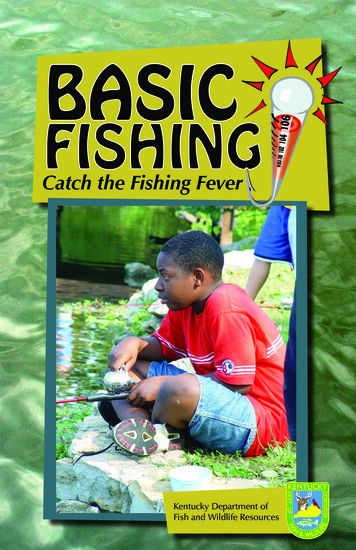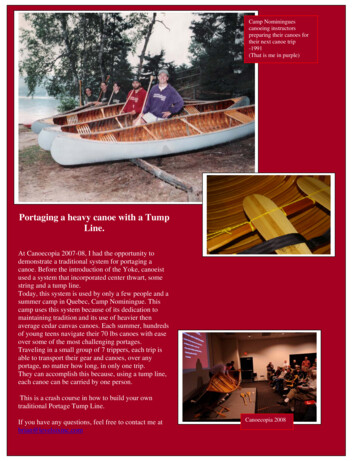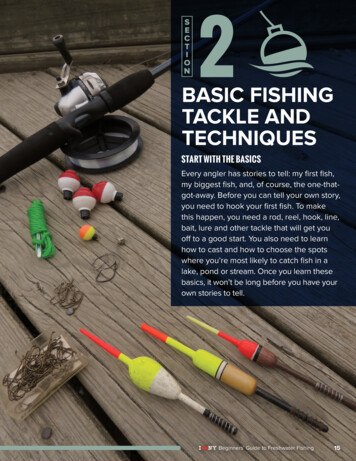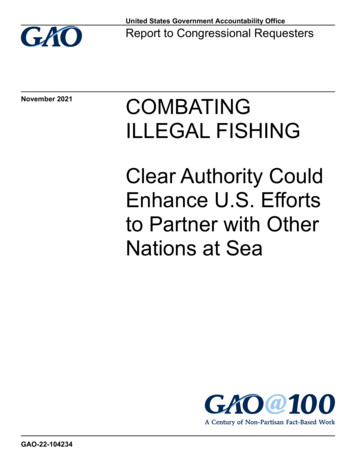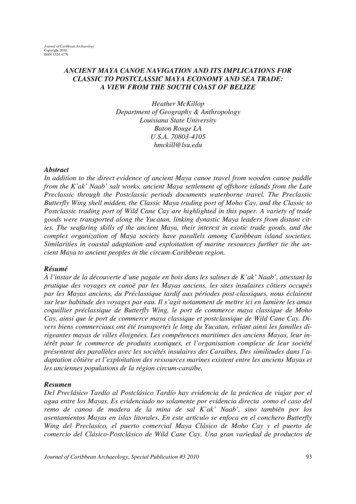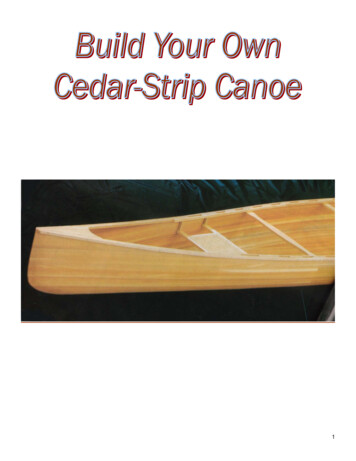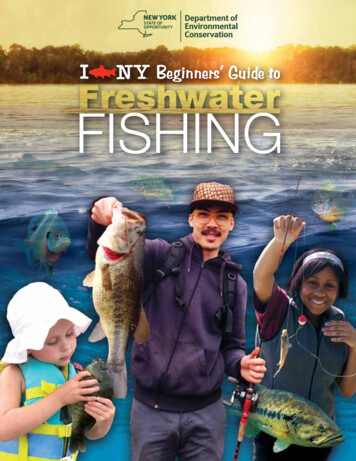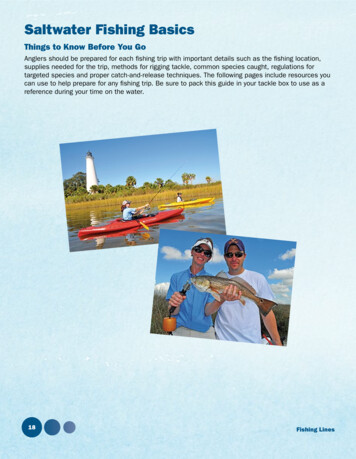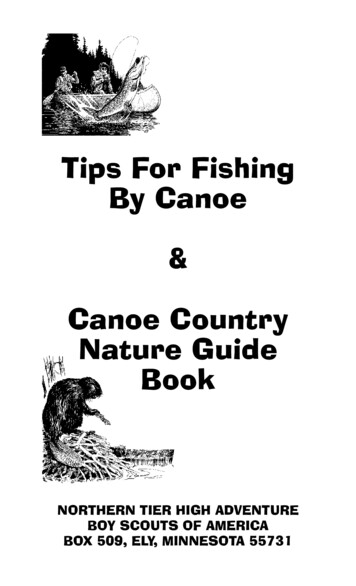
Transcription
Tips For FishingBy Canoe&Canoe CountryNature GuideBookNORTHERN TIER HIGH ADVENTUREBOY SCOUTS OF AMERICABOX 509, ELY, MINNESOTA 55731
Tips on Fishing By Canoe &Canoe Country Nature BookNorthern Tier covers some of the finest canoecamping country in Minnesota, Ontario and Manitoba. The fishing portion of this booklet is designed toshow some of the angling methods which have beenmost effective in these areas.Some of the most spectacular gamefishing inNorth America is available in the waters coveredby Northern Tier. The principle species are walleye,bass, northern pike and lake trout. There are alsopanfish - yellow perch, sunfish and rock bass - andin the Bissett area are an abundance of large channelcatfish.The nature portion of this book is dedicated to allthe Scouts who have travelled these trails before andblazed the way for those of us who travel now.andfor those yet to come.Written and illustrated by Bob Cary, with the helpand cooperation of the staff of the Northern TierNational High Adventure Program, Ely, Minnesota.Author/Illustrator - Bob Cary 2009 Northern Tier High Adventure - BSAThis book belongs toPrinted by the Ely Echo, Ely, Minnesota.
Methods ofFishing by CanoeCanoe fishing is considerably different from fishing by motorboat. Canoes allow anglers more mobility and the opportunity toget into more remote, seldom-fished waters. However canoes aremore confining and care must betaken to remain centered on theseats whether casting, fighting afish or landing a fish.The stern paddler must essentially act as the “guide,” maintaining control of the craft. Becausewind is a factor in controlling acanoe, the stern paddler executesby back-paddling or “sculling.”This is performed by gripping thepaddle near the blade and “locking” the shaft against the body,behind the elbow. This allows thestern paddler to control the craftand at the same time frees one hand for handling his fishing rod.Veteran canoe anglers carry 50 feet of nylon line which can belashed to a rock for an anchor. The canoe can be positioned off theedge of a weed bed, sunken bar or rockpile, the anchor droppedfreeing both anglers to do some serious fishing, unaffected by thewind. Since Northern Tier operates in rocky country, there is neverany shortage of “anchors.”Smart anglers use mainly single-hook lures. Lead-headed jigscan be bolstered with plastic “twister” bodies providing a variety ofcolors. Also, single spinners can be added as further attractors.Single hook lures are the safest to use when casting or landing afish and will take all of the gamefish in the Northern Tier area. Also,a lot of them can be carried in a pouch or plastic bag, eliminatingthe need for a big tackle box.1
WALLEYESThese are the premier fish of the north country. In addition toproviding some excellent sport, they are superb eating, particularly the smaller ones, from a pound to two pounds. Walleyes aremost often found onor near the lakebottom.Single hook jig lures, essentially a hook with a lead weight fora head, are excellent for walleyes. The addition of a plastic grub or“twister” tail adds effectiveness. So does a strip of pork rind andpieces of fish meat. In warm weather and in more heavily-fishedareas, a jig tipped with a leech or half of a nightcrawler can be veryeffective. Leeches may be kept alive on a canoe trip by changingthe water several times each day. Nightcrawlers can be kept instyrofoam boxes filled with worm bedding or Sphagnum moss.Live bait must be kept in the shade or it will die.Walleyes can also be taken on minnow-imitation lures cast ortrolled back of the canoe. If cast, it is sometimes advisable to adda sinker, perhaps 18 inches above the lure. Minnow-imitations areusually equipped with two or more triple gang hooks. These can bea hazard and care must be taken when casting or landing a floppingfish to keep the hooks away from fingers, legs and clothing.Choice walleye spots are the edges of rock piles, ledges andreefs, the outside edge of weed beds called the “weed line” or“breakline” and on long, sloping sand or gravel bars. Where streamscome into lakes, walleyes are usually found in the currents and inthe eddies alongside the depth currents.2
NORTHERN PIKENorthern pike are numerous and a very active fish species.Normally, they hang out in fairly shallow water, around weedbeds, rocky reefs and currents where streams enter lakes. Theywill strike almost any type of lure from fast-retrieved surface baitsto spoons, spinners and jigs. In areas where northern pike arenumerous it pays to fish with a wire leader. Probably the easiestway to make contact with pike is with metal, flashing lures suchas spinners and spoons. It takes a fairly heavy line and stoutrod to take really big pike because the lure must be literally“ripped” through the sharp teeth of the pike to set the hookproperly. Pike are excellent eating once the “Y”bones just above the lateral line are removedfrom thefillets. A specialtrick with pike is tocut up the fillets into inch-square pieces and dip them for aboutthree minutes in rapidly boiling salt water. Taken out of the waterand allowed to drain and cool, they make excellent appetizers oreven main dishes. They are white and rubbery, and are dubbed“poor man’s lobster.” Dipped in melted margarine, they are awilderness treat.Best pike are in the 4-6 pound size. Smaller pikes are hard tofillet and larger pike not nearly as good to eat.Really big pike should not be brought into the canoe. Instead,paddle to a sloping ledge or gravel beach and slide the fish up onthe shore where the hook can be removed. It is imperative to carrylong-nosed pliers when pike fishing to remove the hook withoutgetting a hand too near the big teeth.3
BASSThe acrobats of the northland, bass are spectacular leapers. Inthe spring and early summer, they will strike readily on the surface.Any type of floating lure which can be twitched, gurgled or poppedon the surface will work. Bass also strike readily on jigs-and-grubcombinations and minnow-like crank baits. In late summer and falla jig with a leech or piece of night crawler can be deadly. Bass canbe found in spring and summer in weedy shallows, on gravel barsand in rocky currents, rock reefs and boulder “gardens” where theyseek their favorite food: crawfish. Another good trick, when fishingis slow, is to stalk through reeds and shoreline grass to capture frogs.Used on a plain jig hook, they are nearly irresistible to bass.Bass may be landed by shoving a thumb in their mouth andlifting them from the water with a forefinger under the jaw. Bassteeth are like sandpaper and do not cut. Small bass, in the onepound to three-pound class make excellent eating filleted and friedor baked over the coals. Large bass are female breeders and shouldbe released unharmed.Smallmouth bass are numerous in the Boundary Waters andQuetico Park. Many of the waters around Atikokan are filled withbass. There are few bass around Bissett.4
LAKE TROUTThese silvery, black-spotted trophies of the deep, cold lakesare much sought as a game species. Theirorange meat is particularly tasty.Trout should never be puton a stringer wherethey will turnsoft, butplaced in awet cloth bag suchas an old pillow case. This keeps themcool and firm. Also they are fairly oily anddo not fry up well. Instead, broil them over thecoals by splitting them down the back and laying them skin sidedown. They can be baked in foil pouches with a slice of onion andstrip of bacon on each one. Taste can be added by seasoning theinside body cavity. Trout are simply gutted, the head cut off andthe body cooked whole.Easiest way to catch trout is by trolling a nickel spoon in thespringtime on a long line behind the canoe. Troll at a fairly steadypace. In warm weather, trout can be taken on white jigs or heavymetal spoons sunk 50 feet or more, jigged upward sharply andallowed to flutter down. Trout prefer cold water and tend to staydeep all summer. They do not tolerate warm water and when caughtmust be eaten because they will die if brought up to the surfacein the summer.5
CATFISHRivers in the Bissett area, such as the Bloodvein,are loaded with channel catfish. These can be takenon lures fished slowly or on plain hooks baited withpieces of fish, meat or cheese.Catfish are mainlybottom feedersand the baitmust be sunkto get them.Catfish are excellent to eat. Simply skin them with pliers andeither fillet them or cut them into chunks and fry them.JIGS6Hooks with lead weightsmolded into the head are calledleadheads or jigs. The advantageis in having a single-hook lurethat is compact yet carryinganough weight to be easilycast.
PANFISHPanfish - yellow perch, sunfish and rockbass - are found in alllakes in the Northern Tier areas. These can be caught on tiny jigsor on plain hooks baited with worms or pieces of meat. A simpleway to catch them is to fish around fallen trees or weedbeds witha small bobber to keep the bait off the bottom.Panfish can be scaled, gutted, and fried whole after rolling themin flour and corn meal.MANITOBA REQUIRESBARBLESS HOOKSManitoba fishing regulations require all fishing lures/hooksbe barbless. You can make your lures/hooks barbless by flattening the barb against the shaft of the hook with a pair of pliers.Barbless hooks make for easy release of fish and minimizeinjury to fish that are caught and released.7
Landing Fishfrom a CanoeIt is one thing to get a fish on the hook, another to getit in the canoe. Probably the handiest item is a small landing net,a short-handled net which can be stowed inside a packsack whennot in use. Fish can be landed by grabbing them, but a net preventsgetting fingers stuck on sharp fins, teeth or (in case of walleyes) thesharp gill covers. Also, when in a net, fish cannot thrash around inside the canoe and possibly sink a hook into pants, legs or socks.Fish should be led toward the net andnetted head first. When liftedinto the canoe, the angler cangrip the fish through the net,preventing the fish from slipping while removing it fromthe hook.Fish can also belanded by using a singlecotton glove on the freehand. After fishing isdone, the glove canbe rinsed and wrungout, dried and put inthe pack.Extralarge fish, such asbig pike, may bebeached insteadof bringingthem into thecanoe. Whenthe fish is obviously tired, simply paddle to shore, ease the fishinto the shallows and release it by reaching down with pliers andremoving the hook. If a photo is wished, lift the fish up by grippingit behind the gills, take the photo quickly and put the fish back inthe lake.8
SPECIAL EQUIPMENTFillet KnifeA good, sharp knife with a long, thin, flexible blade is essentialfor cleaning fish. It should be kept secure in a sheath when notbeing used.SharpenerA good sharpening system should be available at home where arazor edge can be honed. For fishing trips, a small steel or diamondedged sharpener will touch up the blade when work needs to bedone. Such a sharpener also can be used to touch up hook pointsthat get dull.Line ClipperFisherman should always use some type of cutter or knife tocut monofilament line, never the teeth. A fingernail clipper on anelastic cord is a handy item.Long-nosed PliersThese are used for taking hooks out of fish and for straightening bent hooks. They should be equipped with side edges forcutting hooks.Reel OilA can of oil and a small tube of gear grease will keep reelsrunning smoothly and make them last years longer.9
Filleting FishRemoving the meatof a fish from the bones andskin makes it easier to cook andeat. Here is one way to do it.A. Laythe fish onits side andmake a cutjust behind thegills down to thebackbone, not through it.B. Start at cut A and run thepoint of the knife alongside the backbone down to where it starts to click along thetops of the ribs. Cut alongside the ribs, workingback toward the tail until the entire side ofthe fish is free from the ribs and backbone,but leave it attached to the tail.C. Lay the side flat and hook a forefinger under the skin near the tail. Runthe knife into the meat next to the skin andhold the blade against the inside of the skin at an angle ofabout 45 degrees. Holding the blade steady, gently lift the forefinger holding the skin and pull. The skin will slide out leavinga boneless, skinless fillet. Repeat onthe other side of the fish and you havetwo steaks.10
Boning Fish11
KNOTS FOR FISHINGContrary to the thinking of many novice fishermen, a simple overhand knot will not do in mostfishing situations. Although a knot may seem insignificant, it can be and quite often is the crucial factor betweensuccess and failure.Improved Cinch KnotThis is the universal knot for tying monofilament to a hook or fortying hooks and swivels - any object having an eye - to a line. Runthe end of the line through the eye, double the line back, and makefive twistsaround theline, leavinga loop. Runthe end of theline through theloop where the line joins the eye and then pass the line through thelarge loop. Partially close the knot and moisten it a little (not withsaliva) before securing it against the eye. Because monofilament isslippery, it takes a knot that will jam against itself and hold tight,yet not cut itself.Palomar KnotThis is another basic knot. Double the line to make a 3- to 4-inchloop, then pass the end of the loop through the eye. Hold the standing part between thumb and forefinger and tie a loose overhhandknot in the double line with the other hand. Then pass the hookthrough the loop and pull on the doubled line to tighten the knot,guiding the loop over the top of the eyelet. Clip the tag end.12
CATCH & RELEASEIt is an idea whose time has come and thousandsof sport fishermen now practice catching and releasing the fish unharmed. There has always been a lot of Catch& Release in the Boundary Waters because there is really no wayto haul a lot of fish out without having them spoil.The rule is: catch what you want for a single meal, clean them,cook them and eat them, but don’t keep any more fish than can beeaten at a sitting. Pay particular attention to releasing the larger fishbecause they are invariably females which are the key to spawningand maintaining bountiful fish stocks in our northern lakes.The best eating fish are the smaller ones, from one to twopounds. A good rule of the thumb is to keep only one fish foreach person in the group.and take extra care in unhooking andreleasing the rest.Catch & Release will insure that the canoe country, from nowto eternity, will always have a bountiful fish supply for sport andfood.Larger fish are invariably femaleswhich are the key to spawning andmaintaining bountifulfish stocks in our northern lakes.13
NOTES14
Canoe Country NatureWhile most of the world thinks in terms of four seasons spring summer, winter and fall - in the north country, we areconcerned mainly with two: open water season and freeze-up.These, as they have for centuries, determine our method oftravel.either by canoe or on foot.First, let us consider the canoe, the finest, lightest displacement hull ever designed by humans. No one has improved onthe basic lines developed by the Indian, our only contributionhas been better materials to replace the birchbark covering.As the Indian used his canoe as a vehicle for fishing, hunting and trapping, so we use our canoes today for travel and fornature study. Paddling silently, it is possible for us to approachand observe, even photograph, many of the birds and animalswhich are found in the wilderness.On the following pages are sketches and notes about someof the species you may see along the northern trails. Some arequite common, even friendly visitors to your campsite. Someare night travellers, leaving only their tracks or their cries in thedarkness to indicate their presence. Some are quite rare and youmay be one of the fortunate few who get to view them in theirnatural habitat.However, no matter how common or how rare, we do notdisturb any of the birds or animals unnecessarily, nor do wetouch their nests or their dens. In so far as possible, we leavethe forest and the waters exactly as we found them. Your canoeis your passport to adventure. Your ability to observe and travelquietly will determine just how much of the wildlife you willsee. Travel on.15
Birds and DucksSpring comesto the north country in late Aprilwhen the snow begins to melt andlakes begin toshedtheir ice. Early arrivals are the LOON, dressed in their brighttuxedos and shouting their crazy cries.The HERRING GULL is anotherearly arrival, circling the lakeslike a gray and white sailplane.A third early spring arrival is theGREAT BLUE HERON, solitary shoreline fisherman, who stands in the shallowsto spear unwary fish. Herons nest in largerookeries, theirbig platformnests containing one tothree squalling, ugly littlesharp-billed brats.16
Largestof the airborne hunters of thenorthern skies is the BALDEAGLE which nests on largeplatforms of sticks atop tallpine trees. Possessing sharpeyes, the eagle can plummetfrom great heights to strikehis prey.or, perhaps to steal afresh fish dinner from the lesspowerful osprey. Once nearlywiped out by fish tainted withchemical pesticides, eagles are nowmaking a slow comeback in the more remote areas ofthe wilderness.proud and fearless rulers of the skies.TURKEY VULTURES are the scavengers of the north, cleaning up the refuse of the forests and lakes. Travelling in squadrons,they soar above the treetops seeking out dead fish or animals uponwhich they seem to dine with great relish.17
BLACKDUCKS nest onthe marshes over much of thecanoe country and are a common sight in the summer withtheir broods of six to twelveyoung. They feed extensivelyon wild rice and are a veryhighly-prized game bird.MALLARDS are less common summer residents than blackducks, but arrive in huge flockseach fall on their migratory tripsto the south. Drakes areeasily identified by theirgreen heads, mahoganychests and white collar.Hens are mottled grayand brown. Mallardsare one of the tastiestof waterfowl.MERGANSERS arebrightly colored and havelong, thin bills used for catchingfish. They nest over most of the canoecountry but are not hunted inthe fall because their fleshis fishy tasting.18
Song birds of the canoe country include thatcrazy, chatteringhigh diver theKINGFISHER.From his perchover the water,this sharp-billed fisherman diveshead-first into the lake to spearhis lunch with a long, powerfulbill. His large, crested head andblue-and-white color make himeasy to spot.REDWING BLACKBIRDS are found among therushes and cattails along streamsand in marshes. This colorfulsinger is quite tame and will allowcanoes to come very close.In the dead of winter, when the temperature may dive to 50 below zero, there aresome very hardy, year-around residents of the north thatlive quite well in their down parkas. The tiny CHICKADEE isone of the toughest, flitting from cover to cover in search of seeds.With his grayish wings, black throat andcrest, and white cheeks, the chickadee has a coat to match his cheerychirping sound from which he wasnamed. Quite tame, he will readilyfeed from hand.The tiny WHITETHROATEDSPARROWis often heard but seldom seen. Itfrequents the high tree tops andcalls out to all the word, “Let ussing about it.”19
The big,grayishCANADA JAY is also verytame, but visits mainly to seewhat he can steal.whichis why he is often giventhe name of “camprobber.”The BLUE JAY, a handsome dudein his blue, white and black attire,hoarsely cries “Thief! Thief!” at all ofthe other creatures in the woods, while hehimself is the biggest thief of all.Night hunter of the woods, the GREATHORNED OWL isa year-around resident,living on birds and rodents.It is very large with a five-foot wingspan,big sharp talons and prominent ear tufts.The BARRED OWL is a year-roundresident best known for his eerie “Who,Who, Who-Who Aw.”20
Rare over therest of the U.S.,the PILEATED WOODPECKERis fairly common in the canoecountry. A large black and whitebird with a bright red topknot, it iseasily identified in the woods. It isalso unafraid and easy to approachand even photograph.RUFFED GROUSE arethe most colorful gamebirds of the northernforests with their reddishbrown backs, black shoulder patches, tan underpartsand brilliantly barred fantails. They take flightwith a thunder of rocketingwings and make very difficulttargets for the hunter, twolegged or wild. When matingin the spring, cocks can beheard “drumming” in the forest, a sound similar to an old gas engine starting up.The much darker SPRUCE GOOSEis aptly called “fool hen” by woodsmenbecause it will allow anybody oranything to come close. Notnearly as tasty as the ruffedvariety, it is seldom takenby hunters, but is fairgame for furred and feathered predators. The malehas a black neck and chestwith a red eye patch. Bothmale and female have darktails.21
AnimalsThe BLACK BEAR is not somebody to foolwith. While bears do not seek out or provokea fight, they are powerful and have claws likesteel hooks. Food packs not hung up high areinviting to hungry bears and food inside a tentcan result in a ripped shelter. Whenleaving camp, it is a good idea tounzip the tent flap and tie it back.The MOOSE is the lord of the wilderness, huge, powerfuland fearless. A full-grown bullmay reach 1,500 pounds. In thesummer they are found along thecanoe trails in low, swampy areas.In the winter they are moreapt to be in rolling22
country feeding on maple, cedar and aspen.TheWHITETAILDEER is themost common big game animalin the north country. Reddishin the summer, it turns gray inthe fall. Bucks shed antlersin January and grow newones each summer. Deerthrive on new sprouts incut-over or burnt-over land.The TIMBERWOLF looks like huge, grey shepherds do, but has a full, bushy tail.Timberwolves can often be heard running deer at night, theirhowls a trademark.In the winter, the tracks of this mighty hunter are often seen.The print is the size of a mitten.23
The cats of thenorth are careful, quiethunters. The BOBCAT,yellowish-orange and spotted, is the most common,his tracks being seen in theswamps and thickets where heis hunting for his favorite fare,the snowshoe rabbit.Much larger than the bobcat,grayish in color without spots and withlonger ear tufts, is the CANADA LYNX,also a rabbit hunter, butpowerful enough to catchand kill deer fawns. Boththe lynx and the bobcat arevaluable valuable furbearers and their numbersare preserved bystrict trapping laws.One of the most-hunted preyspecies of the northwoods is thevarying hare, the SNOWSHOERABBIT, which changesfrom summer gray to whitein the winter. Hunted byfoxes, wolves, lynx, owls andhawks, he survives due to ahigh rate of reproduction.24
Lucky is the outdoor observer who gets tosee a bright orange RED FOX as he hunts hisdinner. Mice are important lunch items whichfoxes get by pouncingon clumps of marsh grass. Theyare very valuable fur bearers,but also wise and crafty,and not easy for thecareless trapper tocatch.It was the rich, thick fur of theBEAVER which first broughtFrench traders to the northerncanoe trails. The flat tailedbuilder is still a populardweller on the lakes andrivers, his dams and lodgesfound wherever there areample alder, birch andaspen food supplies.25
PORCUPINES carry anawesome set of barbed spearsthat disengage on contact andimbed themselves in the attacker. Porkys, however, areslow-moving, peacefuland not a bit troublesome to camperswho let them alone.One does not need to see a SKUNK toknow it is around.the smell is sharp,distinct, and lingering. Skunks arenot troublemakers, however, andwill only resort to gas warfarewhen threatened. Washing intomato juice or diluted ammoniawill usually remove the scent.MINK have dark brown,glossy coats that make themone of the most valuable furbearers in thenorth, much prizedby trappers.MUSKRATS inhabit the same type of low country where themoose lives. These aquatic mammals build their low, roundedgrass houses with underwater entrances so they can get in andout in the winter when the water surface freezes. Muskratsare valuable furbearers andare important food animalsfor predators such as mink.26
WOODCHUCKS arefound in clearings andgrassy hillsides. Likeother rodents, they arehunted and eaten bylarger carnivores suchas the timberwolf.A night visitor is theFLYING SQUIRREL,quite common but seldom seen. They are lightgray with white underparts, round of face withbig eyes.Clown of the campsites is the CHIPMUNK, tiny and brightly striped withwhite and black. Friendly, they willreadily climb up on a kneeto beg a handout, but they can also cause troubleby eating into food packs.RED SQUIRRELS are found throughout the forests and are frequent residentson campsites. They are tame and can beinduced to eat out of anybody’s hand but theywill also get into packsacks that aren’t lashed tight and eat thecamper’s food.OTTERS are superb fishermen, greatdivers and swimmers. They are alsofun-loving clowns who love to playon mud slides, scooting into thewater for the sheer fun of it. Oneof the most valuable furbearers in the north, they arecarefully protected byconservation regulations.27
TRACKS ANDTRACKINGEvery animal has his own distinct print andthe nature student who can identify tracks can unravel the lifestories the tracks will reveal.MOOSE have large, splithooves that make a marklike a domestic cow, butsharper and deeper.DEER hoof printsare split, sharp, with thetoe points very prominent, the rest often indistinct.T I M B E RW O L Ftracks look like a hugedog’s. Usually, the twofront nails show butthe other nails do notappear.FOX prints are smalland delicate, like a verysmall, narrow-footeddog.BEAR tracks lookmuch like a humanfoot, but with sharp nailmarks. Front feet do notshow the long heel.28
BEAVER havewebbed feet thatshow the web marksin the mud. The hindfoot is much longerthan the front. Nailsshow on both.M U S K R AT Shave webbed feet butusually only the toes,not the webs show inthe tracks.OTTER tracks arerounded with toesand nails prominent.Awkward on land, otter are always foundnear waterways.MINK have small,rounded paws with prominent nail marksalthough the nails may be indistinct inthe snow.SKUNKS have a print somethinglike a miniature bear. The nails usuallydo not show on the back foot, but mayon the front.FISHER are not common, but arefound in the northland in fair numbers.They travel the forests, unlike wateroriented mink and otter.29
Fish and AmphibiansThere are, living beneath the hulls of our canoes, thousands of fish, most of which can furnishus with excellent meals. While at times it mayappear to the unlucky angler that there are indeedno fish at all in the water, it may be our methods or the weather, ora combination of both, which keeps our hooks bare.The persistent fisherman will usually have no trouble gettingenough for himself and his companions, however. Quite often it isjust a simple matter of trolling a spoon or lure 20 to 40 feet behindthe canoe while travelling the last mile or so to camp.During hot weather, when fish may become more selective, itmay be worthwhile to capture a half dozen frogs or perhaps somesmall crawfish for bait.Some of the best spots to find fish congregated are where riversempty into lakes, below rapids and waterfalls in the rivers, andaround the branches where trees have fallen into the lakes. Caremust be taken when fishing to keep hooks from getting stuck inthe fishermen. It is a tedious chore getting a wilderness angler toa doctor.and a painful one.Some fish, such as the northern pike and walleye, have sharpteeth and can cause severe lacerations on fingers. A pair of pliersare indispensable in removing hooks from these toothy critters.While fish abound in the waters of the wilderness and are fineadditions to the trail menu, care should be exercised not to takemore than can be eaten at one time. One ordinary walleye or basswill feed two persons. One large pike will feed four to six. Keeponly what are needed and let the rest gounharmed.LAKE TROUT provideone of the tastiest andnutritious sourcesof food for canoe campers.Tr o u t a r efound inthe clear,cold, deeplakes of of thenorth country. Best baitsfor trout are spoons, spinners and white jigsfished down deep.30
THE WALLEYE is probably the mosthighly-prized food fish, being abundant, easy tocatch and relatively free of small bones. They are found aroundweed beds, rock piles and where streams enter or leave lakes.Best baits are: nightcrawlers,leeches, minnows, frogs,spinners,jigs andminnowshaped underwater lures.NORTHERN PIKE are the meanest, big-toothed predators ofthe lakes, slashing and devouring every other fish, including otherpike. They grow to 40 pounds in size.Northern pike are greenish with yellow or white spots. Theyare prolific, grow rapidly and strike readily onminnows, frogs, or large, flashy lures.31
A favorite food of the pike is the nativeSUCKER, found in almost all of the lakes andrivers in the canoe country. While not usuallyesteemed for its eating qualities, the sucker is excellentsmoked. Suckers can be caughton worms.SMALLMOUTH BASS, aspecies which was introducedinto the northern lakes,is now found overmost of the area.and furnishessome of the finestangling sport. The fishis brownish with dark markings.The LARGEMOUTH BASS is anative fish and can be identifiedby its greenish-silvercolor with blackside markings. Themouthcomeswell behindthe eye, unlike thesmallmouth bass, whose mouthcomes just to the eye. Bothspecies can be caught on worms,leeches, minnows, crawfish, frogs and artificial lures.32
Panfish are easy to catchand make tasty dinners forcanoe travellers. One common species is the ROCKBASS, golden with blackspots and red eyes. Theybite on worms and smalllures such as spinnersand tiny jigs.The PERCH is found inlarge schools around weedbeds. It is easily caught onworms or minnows.BLUEGILLS and SUNFISH offer someof the tast
tially act as the "guide," maintain-ing control of the craft. Because wind is a factor in controlling a canoe, the stern paddler executes by back-paddling or "sculling." This is performed by gripping the paddle near the blade and "lock-ing" the shaft against the body, behind the elbow. This allows the stern paddler to control the craft
